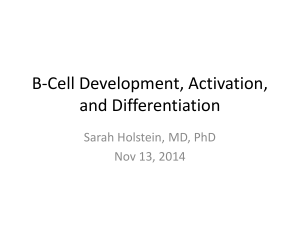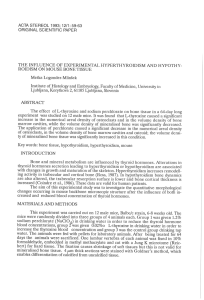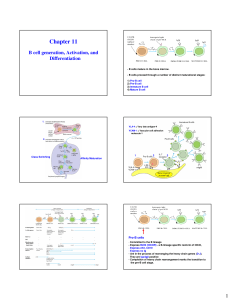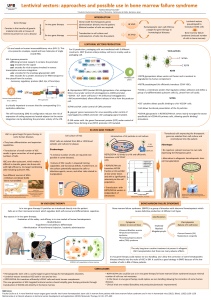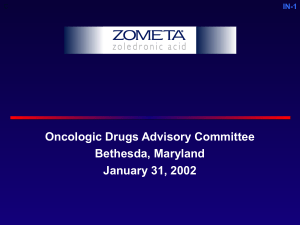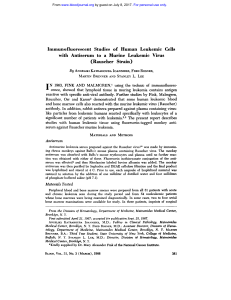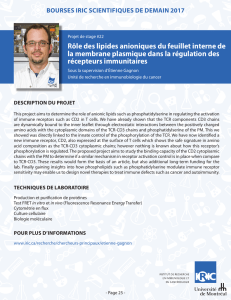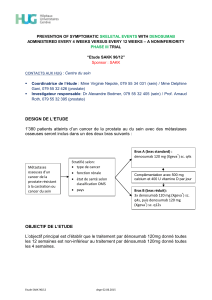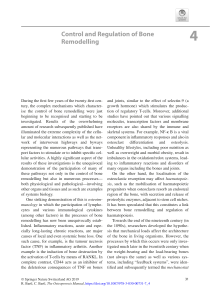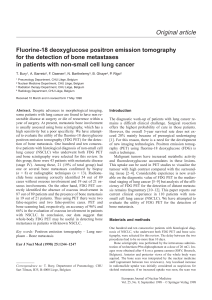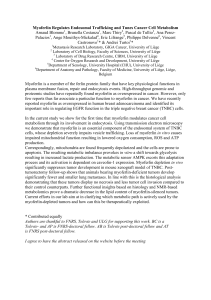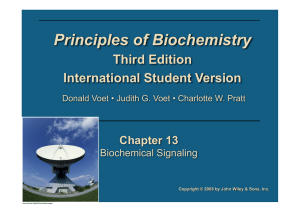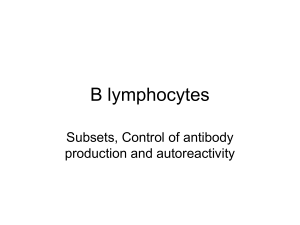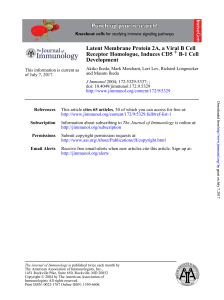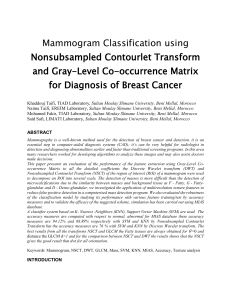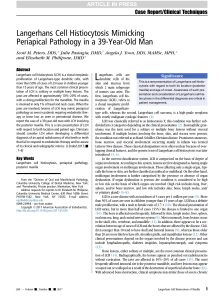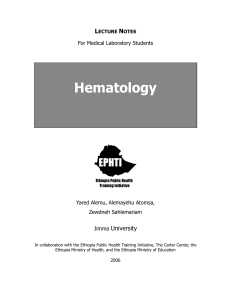College 21 mei
publicité
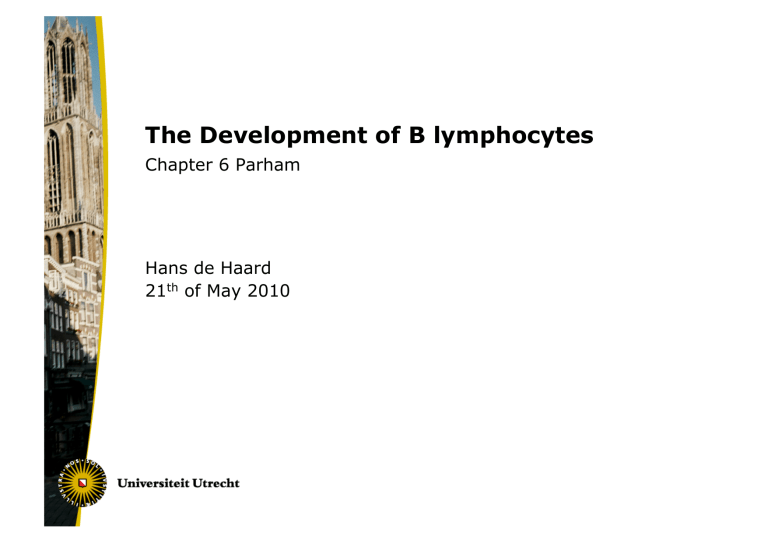
The Development of B lymphocytes Chapter 6 Parham Hans de Haard 21th of May 2010 Agenda • Stages in development of B cells • B cell development in bone marrow • Heavy chain rearrangement • Light chain rearrangement more efficient process • Checkpoints • B1 versus B2 lymphocytes • Removal self reactivity • B cell development in secondary lymphoid tissues • Differentiation into mature B lymphocytes • Maturation into plasma cells and memory cells • Various B cell tumors represent different stages in B cell development Agenda • Stages in development of B cells • B cell development in bone marrow • Heavy chain rearrangement • Light chain rearrangement more efficient process • Checkpoints • B1 versus B2 lymphocytes • Removal self reactivity • B cell development in secondary lymphoid tissues • Differentiation into mature B lymphocytes • Maturation into plasma cells and memory cells • Various B cell tumors represent different stages in B cell development Stages in development B cells • Phase 1: B cell precursors in bone marrow acquire functional antigen receptors via gene rearrangements • Phase 2: elimination anti-self (tolerance) in bone marrow and 2nd lymphoid tissues • Phase 3: positive selection for B cells expression of pathogen specific Ig in 2nd lymphoid tissues • Phase 4: mature B cells circulate via lymph and blood to lymphoid tissues patrolling for infections • Phase 5: proliferation and clonal expansion pathogen specific B-cells in 2nd lymphoid tissues • Phase 6: maturation into: • plasma cells =>remain in 2nd lymphoid tissues, express large quantities pathogen specific Ab • memory B cells (circulate) for rapid Ab generation in case of future infections with same pathogen Agenda • Stages in development of B cells • B cell development in bone marrow • Heavy chain rearrangement • Light chain rearrangement more efficient process • Checkpoints • B1 versus B2 lymphocytes • Removal self reactivity • B cell development in secondary lymphoid tissues • Differentiation into mature B lymphocytes • Maturation into plasma cells and memory cells • Various B cell tumors represent different stages in B cell development Development Immature B cells in bone marrow • B and T cells originate from common lymphoid progenitor cell (CD34+ pluripotent hematopoietic stem cell) • Earliest B cell lineage is early pro-B cell with starting DH – JH rearrangements • Late pro-B cell VH rearranges with DJ, in pre-B cell stage VL with JL • In immature B cell stage IgM expressed on surface Heavy chain rearrangement inefficient process • Due to imprecise joining and addition of N / P nucleotides during VDJ recombination (3 vs 2 segments for light chain) high probability for incorrect reading frame yielding non-functional Ab => non-productive rearrangement • Check for correctly expressed heavy chain; if not, then rearrangement of other chromosome • If again non-productive arrangement, then cell dies by apoptosis • Just over half of total number of B cells make functional heavy chain Quality check (pre-) B cell receptor • Correctly rearranged m heavy chain capable to combine with light chain • Check performed in ER with surrogate light chain consisting of VpreB and l5 in pre-B cell receptor • IgM incorporated in cell membrane via MC, but associated Iga / Igb responsible for signaling • Final check with rearranged light chain in B cell receptor expressed on cell membrane • After successful VDJ recombination on first chromosome assembled pre-B cell receptor signals to stop recombination of 2nd chromosome (allelic exclusion) Light chain rearrangement more efficient process • Large pre-B cell with rearranged heavy chain divides yielding approx. 100 cells per B cell clone (i.e. with identical VDJ) • Kappa light chain rearranges first, if unsuccessful followed by lambda • Only V and J need to recombine, therefore higher success rate then with additional D • If first recombination fails to give correct fusion, then other V region in upstream position will recombine with downstream J • If again non-productive, then recombination of kappa locus on other chromosome • If kappa fails, then lambda locus rearranges • 85% of pre-B cells yield productive light chain rearrangement Checkpoints during B cell development in bone marrow • Check (1): pre-B cell receptor with correct VDJ fused to m heavy chain and associated with surrogate light chain (in vesicle) • Check (2): B cell receptor with correctly rearranged light chain and heavy chain (on cell membrane) m Regulated and time dependent expression of proteins involved in Ig rearrangement • Expression of signaling proteins important for differentiation and development of B cell: • FLT3 => receptor kinase, receives signal stromal cells for differentiation of common lymphoid progenitors • CD19 => co-receptor participating in Ag – BCR complex • CD45 => receptor phosphatase modulating signals from Ag – BCR complex • RAGs are expressed two times, during rearrangement of heavy and later during light chain locus Pax-5 opens up chromatin in heavy chain locus: start recombination • Pax-5 is B cell specific transcription factor • Binds enhancer elements downstream (i.e. 3’ direction) of constant region • Thereby opens up chromatin resulting in low level transcription from promoters upstream (5’) of D and J • Transcription allows access of RAGs to “open” HC locus to start recombination of D – J • Brings enhancer closer to V region leading to transcription from promoters upstream of V • Induces V recombination with DJ B1 versus B2 lymphocytes • Minority human B cells are of B1 class => CD5 marker typical for T cells => little or no surface IgD • Arise from stem cell active in prenatal period and therefore less developed => use V genes closely positioned to D => no or limited TdT activity (i.e. few N nucleotides introduced) • Low affinity antibodies and polyspecific (i.e. reactive against multiple antigens), often carbohydrates recognized • When generated in postnatal period these are better developed and matured; no longer produced by bone marrow, but are self-renewal at sites in peripheral circulation (IL-10 dependent) • Chronic lymphocytic leukemia caused by B1 cells Summary B cell development in bone marrow Removal self-reactive antibodies • Self-reactive immature B cells removed => 75% total population • Potential multivalent self antigens are glycoproteins, proteoglycans and glycolipids on cells • Negative selection starts in bone marrow on self antigens presented by stromal and hematopoietic cells • Immature B cells with self reactivity are maintained within bone marrow, others will go into circulation Receptor editing for changing self reactivity • Self reactivity detected in bone marrow => binding to mutivalent antigen => signaling to reduce surface expression IgM • Maintaining RAG expression => excision old light chain => replaced by newly recombined light chain (receptor editing) • If self reactivity has been removed, then B cell development continues • If not, B cell in apoptosis (clonal deletion) Self reactivity against monovalent antigen results in anergy • Self reactivity detected in bone marrow => binding to monovalent antigen => B cells inactivated and unresponsive against antigen (Anergy) • Anergic cells: => no production cell surface exposed IgM (remains intracellular) => only IgD presented (not activating) => go into circulation, short T½ (1 – 5 days vs 40 days for other B cells) • Central tolerance: check within bone marrow leading to removal of anti-self or anergy • Peripheral tolerance: removal of anti-self outside bone marrow (i.e. by apoptosis or anergy) Agenda • Stages in development of B cells • B cell development in bone marrow • Heavy chain rearrangement • Light chain rearrangement more efficient process • Checkpoints • B1 versus B2 lymphocytes • Removal self reactivity • B cell development in secondary lymphoid tissues • Differentiation into mature B lymphocytes • Maturation into plasma cells and memory cells • Various B cell tumors represent different stages in B cell development Maturation B cells in secondary lymphoid tissues • Immature B cells developed in bone marrow recirculate between blood and secondary lymphoid tissues • Development from immature (sIgM, IgD) into mature B cells (sIgM, IgD) occurs within secondary lymphoid tissues: => enter lymph nodes through walls High Endothelial Venules (HEV) driven by chemotaxis (gradient of chemokines) => guided by other chemokines to primary lymphoid follicles, i.e. network of Follicular Dendritic Cells (FDC) => contact FDC and B cells; if no encounter with antigen B cell detaches and goes back in circulation via lymph • Now developed into mature naive B cell; survival dependent on regular passage through primary follicles of secondary lymphoid tissues; long T½ (~100 days) Differentiation of activated B cells into plasma cells • Encounter of mature naive B cell with antigen leads to interaction with antigen specific TH: activation leads to proliferation and differentiation into plasma cells • Change of phenotype: => expression of secreted IgM ( sIgM-) => not sensitive for signaling, not dividing • Migration to primary follicle thereby becoming secondary lymphoid follicle with germinal centers • B cells become large proliferating centroblasts, subsequent maturation into more slowly dividing centrocytes (isotype switch and affinity matured) • As primary response subsides differentiation in memory cell (picture lymph node see p 210) Various B cell tumors reflect different development stages of B cells • Mistake in rearrangement can lead to activation of oncogenes (controling cell growth, division and differentiation) • B cell tumors are clonal, i.e. derived from single recombined B cell • B cell tumors represent different stages of B cell development • Tumors derived from naive B cells grow in follicles of lymph nodes => follicular center cell lymphoma • Tumors derived from plasma cell tumors grow in bone marrow => myeloma Summary B cell development The Development of B lymphocytes Chapter 6 Parham Hans de Haard 21th of May 2010
